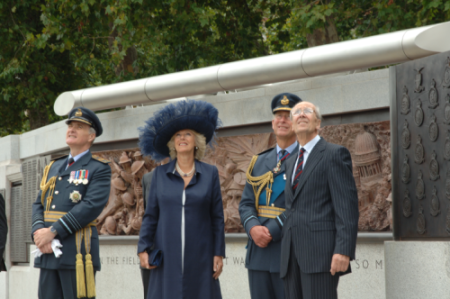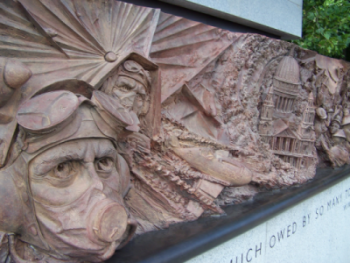Battle of Britain Monument, London
- Clare Wilson
- Mar 14, 2022
- 4 min read
Updated: Apr 20, 2022
Allied Air Force Research would like to thank Edward McManus
for contributing the following guest article to our website.
Note- that Edward is not Affiliated to the Allied Air Force Research Website.
The Battle of Britain London Monument is situated on Victoria Embankment in London, opposite the newly-sited Scotland Yard. It was constructed in 2004/5 from a defunct smoke outlet from the District Line that runs beneath.
The monument was unveiled on Sunday 18th September 2005 by Prince Charles to intense media interest, not least because it was his first public function accompanied by the Duchess of Cornwall, they had married in the previous April.

Bronze sculptures, by the British sculptor Paul Day, show scenes from the conflict in the air and on the ground. These are flanked by bronze panels bearing the names of all 2937 airmen, from fifteen countries, deemed to have flown in the Battle. The term 'airmen' is used as not all were pilots. Blenheim, Beaufighter and Defiant aircraft carried air gunners and observers.
Airmen came from the following countries:
Great Britain – 2342
Australia – 32
Barbados – 1
Belgium – 28
Canada – 112
Czechoslovakia – 88
France – 13
Ireland – 10
Jamaica – 1
Newfoundland – 1
New Zealand – 127
Poland – 145
Rhodesia – 3
South Africa – 25
United States – 9
(Newfoundland was an independent country until 1949).
The figure of 2937 requires explanation as it hardly corresponds with Winston Churchill's lauding of the airmen as "The Few".
The term "Battle of Britain" was bandied about as early as 1941 as shorthand for the intense air fighting in the summer of 1940.
In 1945 it was decided to issue a "Battle of Britain" Clasp to the 1939-45 Star to those qualifying airmen.

It was then necessary to fix the start and end dates of the Battle. Fortunately (Lord) Hugh Dowding, the head of Fighter Command in 1940, was available to consult his diaries and the official records. He decided that the post-Dunkirk German air attacks had reached a worrying level on 10th July 1940, continued with increasing intensity until a climax in September, but were still on a sufficient level to set an end date of 31st October 1940.
The next step was to set a qualifying number of operational sorties i.e. not training or other flights. An operational sortie is one where an aircraft is sent to engage a known enemy incursion, it is counted as one even if the enemy is not able to be engaged or not even seen.
It was readily apparent that the number of qualifying sorties would have to be set at one as several airmen were shot down and killed on their first sortie.
Fighter squadrons were required to protect the shipyards at Belfast, the Royal Navy base at Scapa Flow, critical ports at Liverpool, Cardiff, Portsmouth and Plymouth plus aircraft factories. Given this, it can then be seen that the figure of 2937 airmen spread over three and a half months and the entire country rapidly diminishes to perhaps 200-250 on a given day in the heaviest fighting in the South-East.
Also 544 airmen (19%) were lost in the course of the Battle. 795 were lost later in the war.
The monument had cost £2 million, raised by public subscription by a committee headed by (Lord) Norman Tebbit. In 2006 it was handed over to the perpetual care of Westminster City Council.
It was then realised that future generations that came across the monument would have no access to the background of those named on the bronze panels ("Oh, look, Pilot Officer W Smith. Wasn't great-uncle Bill in the RAF in the war ?").
Construction of the Battle of Britain Monument website was then commenced with the intention of having a photograph and 'mini-biography' of each airman together with a reference to the grave or memorial to those killed in action. Permission was kindly granted by Kenneth Wynn, author of the book 'Men of the Battle of Britain, to use the entries in his book as a jumping off point for each webpage. The content has now multiplied many times over.
Relatives were contacted by writing to those of identical surnames in the airman's home town, taken from old phone directories, plus many other methods. Many came forward of their own volition.
Much remains to be done. A substantial minority of airmen still have only a few lines of text and no photograph, often not even their date of birth is known. This is often the case where the airman was an only child and was killed, his parents and other relatives are long gone.
At time of writing (2022) the website looks dated and unflashy compared to current websites but this curiously fits its ethos, referring to events 80+ years ago.
Sign up to our website now & don’t miss out on future articles & newsletters.
Struggling with your own Air Force Research? Contact us for a FREE Consultation Now!
#genealogy #genealogyresearch #genealogychallenge #GenealogyGems #genealogyiscool #genealogyisfun #genealogywork #genealogyuk #genealogytree #genealogynerd #genealogyguys #familytree #familytrees #familytreeevents #family #familystories #familyhistory #familyhistoryiscool #familyhistoryisfun #familyhistoryresearch #ancestryinprogress #ancestryresearch #ancestors #uk #raf #bombercommand #AirForceVeteran #airforce #RoyalAirForce #bombers #ww2aircraft #ww2bomber #ww2plane #ww2planes #ww2aviation #aircrew #aircrews #aircrewlife #aircrewman #ww2 #ww2history #ww2daily #ww2vet #ww2veteran #ww2collector #ww2photo #ww2museum #ww2collections #worldwar2 #worldwar2history #worldwar2incolor #worldwar2memorial #worldwar2photos #worldwar2foryou #worldwar2museum #WorldWar2Vet #worldwar2veteran #WorldWar2Veterans #worldwartwo #worldwartwomilitaria #worldwartwomilitary #veday #75thanniversaryofveday #alliedairforceresearch #freefrenchairforce #ffaf #rcaf #royalcanadianairforce #raaf #royalaustralianairforce #rnzaf #royalnewzealandairforce #saaf #southafricanairforce #paf #polishairforce #rnaf #royalnetherlandsairforce #royalnorwegianairforce #rhaf #royalhellenicairforce #fightercommand #battleofbritain #theblitz #battleofbritainday #london #battleofbritainmonument #fightercommand

.jpg)
























